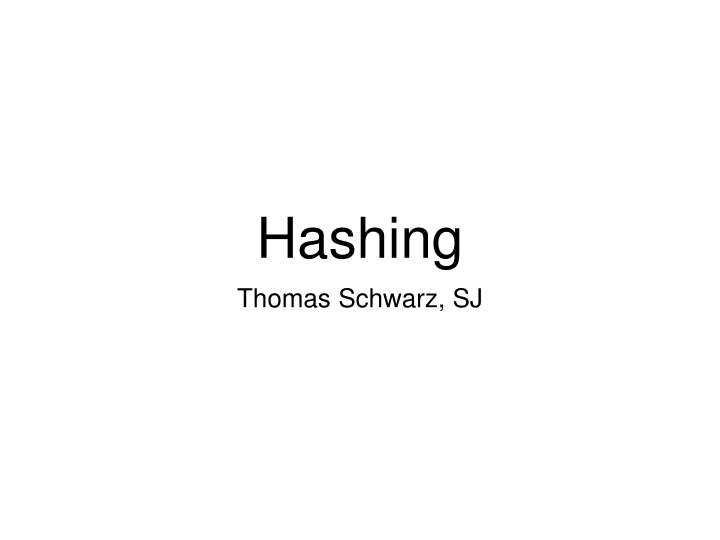
Dictionary, Direct Addressing, and Hash Tables in Data Structures
Explore the concepts of dictionary data structure for key-value pairs with CRUD operations, direct addressing using arrays, and hash tables for efficient storage and retrieval of data elements. Learn about handling collisions and different approaches for storing key-value pairs in the context of data structures.
Download Presentation

Please find below an Image/Link to download the presentation.
The content on the website is provided AS IS for your information and personal use only. It may not be sold, licensed, or shared on other websites without obtaining consent from the author. If you encounter any issues during the download, it is possible that the publisher has removed the file from their server.
You are allowed to download the files provided on this website for personal or commercial use, subject to the condition that they are used lawfully. All files are the property of their respective owners.
The content on the website is provided AS IS for your information and personal use only. It may not be sold, licensed, or shared on other websites without obtaining consent from the author.
E N D
Presentation Transcript
Hashing Thomas Schwarz, SJ
Dictionary ADS for key-value pairs CRUD operations: Create Read Update Delete Does not assume nor support ordering of keys
Dictionary Example: A compiler takes a variable name (= key) and associates various data such as type etc. (value)
Direct Addressing If the key space is small Use Direct Addressing Array for all possible key values with pointers to values Null-pointers (None) if key not in the dictionary
Direct Addressing Direct addressing: Number of actual keys needs to be close to the number of possible keys Keys need to be convertible to indices
Direct Addressing Direct addressing: Number of actual keys needs to be close to the number of possible keys Keys need to be convertible to indices
Direct Addressing Variants: The value can be stored directly in the array E.g.: When the value has fixed length
Hash Tables If the universe ? of keys is large Table with |?| entries is too big And most of its entries would be Nones Use a hash function :? {0,1, ,? 1} with few collisions A collision are two elements of ? that map to the same number ?1,?2 ?,?1 ?2, (?1) = (?2)
Hash Tables Collisions happen and they must be resolved Chaining: create a linked list of key-value pairs
Hash Tables Bucketing A linked list is not necessarily the best way to store key- value pairs If the hash table is large, the data will be stored in the pages of a storage system Can have buckets with a given maximum capacity However, we might need to have overflow buckets
Hash Tables A potential design for buckets: Each bucket has a next pointer to an overflow area And in this case a fixed capacity to store key-value pairs Here: a full bucket with one overflow record
Performance of Hashing with Chaining Vocabulary: A hash table ? has ? slots with ? records. Its load factor is ? = ?/?. ? = 16 ? = 8 ? =1 2
Performance of Hashing with Chaining Worst performance: The hash function maps all record keys to the same slot Finding a key-value pair then takes ? accesses to a key-value pair if the record is not there On average (? + 1)/2 accesses if the record is there because (1 + 2 + + ?)/? =(?+1)? =?+1 2? 2
Performance of Hashing with Chaining Why would this happen: The hash function is bad This happens if people make up their own hash functions The data is cooked "Adversary model": Evaluate algorithms and ADS by finding the worst possible instance of data Someone controls the input and is attacking your system Bad luck Murphy's law: If something bad can happen, it will happen eventually
Performance of Hashing with Chaining Average performance analysis: Assume that a hash function is equally likely to send a record to a certain slot This can be de facto guaranteed with cryptographically secure hash functions (see below)
Performance of Hashing with Chaining Call ?? the number of records (= key-value pairs) that are hashed to slot ? (? {0,1, ,? 1}) Then ?0+ ?1+ ?? 2+ ?? 1= ? Expected number of records accessed for an unsuccessful search: Equal to the length of the chain, i.e. to ?? On average: ?0+?1+?2+ +?? 2+?? 1 ? Total expected work: Need to calculate the hash function etc. (1 + ?) (the one because ? can be zero.) ? ?= ? =
Performance of Hashing with Chaining Successful search: In a list of ? records, we access on average ?+1 If each record were in a random slot: Average number of records accessed during a successful search is therefore 2 records ?0+1 2 +?1+1 + ?? 2+1 +?? 1+1 2 2 2 ? =?0+?1+ +?? 2+?? 1+? 2? = ?+? 2?=1 2? + 1 = (1 + ?)
Performance of Hashing with Chaining Successful search: But records are more likely to be in full slots Therefore, this analysis is false Probability that two keys are in the same slot is 1 A search for a record visits exactly those records that: Are in the same slot And have been inserted before ?
Performance of Hashing with Chaining Order all records [?0,?0],[?1,?1], ,[?? 1,?? 1] by insertion Then search for ?? touches all records with ?0,?1, ,?? 1 But only if they are inserted into the same slot which happens with probability 1 Therefore: Search for record ? looks at ? ? ? records plus itself
Performance of Hashing with Chaining Search for record ? looks at ? On average: ? records plus itself ? 1 1 ? (? ?+ 1) ?=0 ? 1 1 = 1 + ?? ? ?=0 = 1 +?(? 1) 2?? ? 2?? = 1 +1 1 1 = 1 + 2? 2? 2??
Hash Functions A good hash function: each key is equally likely to hash to any of the ? slots independently where any other keys are hashed to Usually cannot be ascertained: We do not know enough about the distribution of keys
Hash Functions Example: Assume that keys are random number between 0 and 1 Good hash function is: (?) = ? ? import random m=5 def hash(u): return int(u*m)
Hash Functions Interpreting keys as natural numbers Many hash functions work on natural numbers Need to translate to integers: Example: For strings: convert encoding to numerical representation def str_to_int(astring): result = 0 for letter in astring: result = ord(letter) + 256*result return result
Hash Functions Example def str_to_int(astring): result = 0 for letter in astring: result = ord(letter) + 256*result return result
Hash Functions Caution: The transformation and the hash function combination can have weird effects E.g. A string obtained by swapping to letters might have the same hash Which could be useful or could be very bad
Hash Functions Simple hash functions: Division method: Convert keys to integers Then hash to the integer obtained as remainder by division with ? def hash(key): return key_2_int(key)%m
Hash Functions Division method: If ? is a power of 2: Hash is the last bits Which is usually bad If ? = 2? 1 and keys are strings: swapping two letters does not change the hash value Better experience: Primes close to a power of 2
Hash Functions Multiplication Method: Key ? is a l bit value Use a constant ? of size l bits Multiply: ??, a 2l bit value Select hash as upper bits of the lower half
Hash Functions How to select ?: 5 1 2 D. Knuth proposes to use the first l bits of
Hash Functions Example: 32-bit keys ? = ( 5 1)/2 Extract 14 bits: Shift right by 18 (14+18 = 32) Then mask with 14 ones: b11 1111 1111 1111 = 0x3fff s = int((math.sqrt(5)-1)/2 * 2**32) def hash(x): return (s*x >> 18) & 0x3fff
Hash Functions Cryptographically secure hash functions: Hash functions have applications in security Instead of storing a password, store the hash of a password together with the user name "user_name", h(pass_word) When user enters the password: System calculates the hash of the entered password And compares with the hash
Hash Functions Cryptographically secure hash functions: Generate long hashes (224 - 512 bits) If an attacker steals the user database: Attacker has only the hash, but not the password Cryptographically secure hash function : Impossible to calculate ? from (?)
Hash Functions This is why you should not choose words in a language as password: "peaches" Attacker can try out All words in English (~200,000), All words in Hindi ShabdSagar (~93,000 - 250,000)
Hash Functions Secure hash functions are the result of competitions and public scrutiny Provide pre-image resistance: Impossible to find ? from (?) Provide collision resistance: Impossible to find ? and ? such that (?) = (?) Certified by NIST and similar institutions SHA-3 (NIST) Blake3 (latest considered to be safe)
Hash Functions Should you use cryptographically secure hash functions? If your data cannot be generated by an adversary If you can live with small inadequacies Not necessary Otherwise: Extract as many bits as needed from a cryptographically secure hash function Pay the performance costs
Open Addressing Hashing Idea: Records (= key-value pair) are stored in the hash table itself Collisions are resolved by storing a record elsewhere
Open Addressing Hashing Linear probing: If a slot is occupied, go to the next slot
Open Addressing Hashing Linear Probing Example: 16 slots Hash function %16
Open Addressing Hashing Linear Probing Example: 16 slots Hash function %16 Insert 100 100%16 = 4 Insert into slot 4
Open Addressing Hashing Insert 85 85%16 = 5 Insert into slot 5
Open Addressing Hashing Insert 120 120%16 = 8
Open Addressing Hashing Insert 200 200%16 = 8 But slot 8 is occupied Put into slot 9
Open Addressing Hashing Insert 255 255%16 = 15
Open Addressing Hashing Insert 20 20%16 = 4 Try slot 4 Then slot 5 Then insert into slot 6
Open Addressing Hashing Linear probing implementation class Hashtable: def __init__(self, slots): self.array = [None]*slots self.hash = lambda x : x%slots
Open Addressing Hashing Linear probing implementation class Hashtable: def __repr__(self): retVal = '' for i in range(len(self.array)): retVal += '{}: {}\n'.format(i, self.array[i]) return retVal
Open Addressing Hashing Linear probing implementation class Hashtable: def insert(self, key, value): slot = self.hash(key) while True: if self.array[slot]: slot = (slot+1).len(self.array) else: self.array[slot] = (key,value) return





